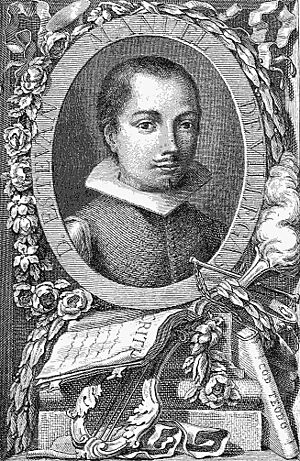Esteban Manuel de Villegas facts for kids
Esteban Manuel de Villegas (born February 5, 1589, in Matute, La Rioja – died September 3, 1669, in Nájera, La Rioja) was a Spanish poet from the 1600s. He is known for his unique style of poetry.
About His Life
Esteban studied grammar in Madrid. Later, he went to the University of Salamanca. He earned a law degree there. But he never worked as a lawyer.
He was a royal treasurer in Nájera. However, he didn't get other jobs he wanted. Even though his family was rich, he often had money problems. This was because he had many children and was always involved in lawsuits. When he was 36, he married Doña Antonia de Leyva Villodas. She was 20 years younger than him.
In 1659, he had a problem with the Spanish Inquisition. This was a powerful religious court. They thought he believed he knew everything. He was put in jail for a short time. He had also written some critical poems about religious groups. Many of these poems were lost. The Inquisition ordered him to live away from his home for four years. But he was pardoned after only one year. He died in Nájera when he was 80 years old.
His Writings
Villegas wrote a very original poetry book called "Las Eróticas." It was published in Nájera in 1618. This book was reprinted many times later. The book's title page had a special saying. This saying made some people think he was too proud. He even tried to remove this saying from copies of his book.
His book "Las Eróticas" has two main parts. The first part uses short lines. It is like the ancient Greek style called Anacreontic. The second part uses longer lines. It tells stories from history. The book has many delicate poems. He was very skilled at writing them. It also includes his own versions of poems by Horace. There are also sad poems (elegies), peaceful poems about nature (idylls), short witty poems (epigrams), and some sonnets.
Villegas tried to use old Greek and Roman poetry styles in Spanish. This made his poems very formal. He helped set the stage for a new style of writing called Neoclassicism in the 1700s. His longer poems sometimes used a complex style called Culteranismo. An example is his "Ode to Philip III."
He also tried to make Spanish poetry sound like the Anacreontic style. Many poets in the 1700s copied his way of writing. Famous poets like Juan Meléndez Valdés and José Iglesias de la Casa were influenced by him. His graceful pastoral songs, called "Cantilenas," were also widely copied.
When he was older, he translated a book by Boethius called "De consolatione Philosophiae." This book was about finding comfort in philosophy. After his experience with the Inquisition, he left the part about free will in Latin. This was a way to be careful. He also wrote two volumes of "Disertaciones." These were comments on old classic writings that are now lost. He also wrote "Discurso contra las comedias" and "Antiteatro," but these were never published.
|
Dulce vecino de la verde selva |
Sweet neighbor of the green forest, |
| —"Saphicos", lines 1-4 |
See also
 In Spanish: Esteban Manuel de Villegas para niños
In Spanish: Esteban Manuel de Villegas para niños


